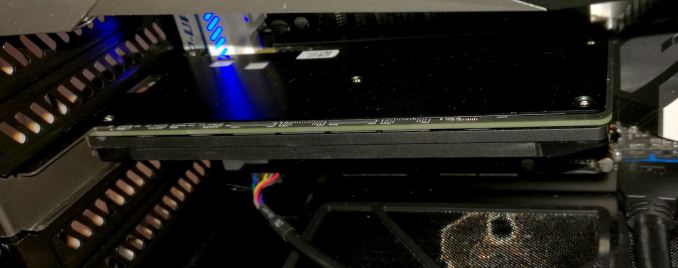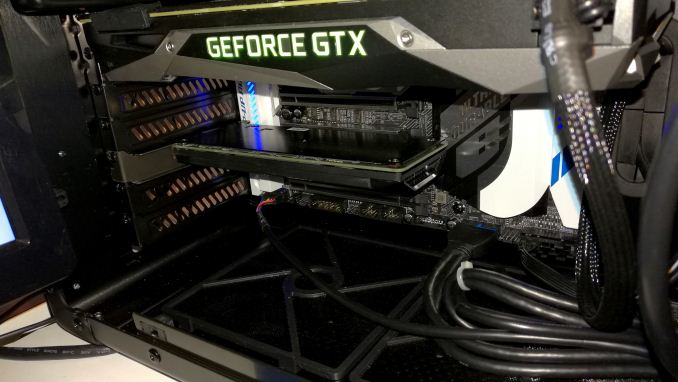Intel’s 140GB Optane 3D XPoint PCIe SSD Spotted at IDF
by Ian Cutress on August 26, 2016 12:01 PM EST- Posted in
- SSDs
- Intel
- Enterprise
- Enterprise SSDs
- 3D XPoint
- IDF_2016
- Optane

As part of this year’s Intel’s Developer Forum, we had half expected some more insights into the new series of 3D XPoint products that would be hitting the market, either in terms of narrower time frames or more insights into the technology. Last year was the outing of some information, including the ‘Optane’ brand name for the storage version. Unfortunately, new information was thin on the ground and Intel seemed reluctant to speak any further about the technology that what had already been said.
What we do know is that 3D XPoint based products will come in storage flavors first, with DRAM extension parts to follow in the future. This ultimately comes from the fact that storage is easier to implement and enable than DRAM, and the characteristics for storage are not as tight as those for DRAM in terms of break-neck speed, latency or read/write cycles.
For IDF, Optane was ultimately relegated to a side presentation at the same time as other important talks were going on, and we were treated to discussions about ‘software defined cache hierarchy’ whereby a system with an Optane drive can define the memory space as ‘DRAM + Optane’. This means a system with 256GB of DRAM and a 768GB Optane drive can essentially act like a system with ‘1TB’ of DRAM space to fill with a database. The abstraction layer in the software/hypervisor is aimed at brokering the actual interface between DRAM and Optane, but it should be transparent to software. This would enable some database applications to move from ‘partial DRAM and SSD scratch space’ into a full ‘DRAM’ environment, making it easier for programming. Of course, the performance compared to an all-DRAM database is lower, but the point of this is to move databases out of the SSD/HDD environment by making the DRAM space larger.
Aside from the talk, there were actually some Optane drives on the show floor, or at least what we were told were Optane. These were PCIe x4 cards with a backplate and a large heatsink, and despite my many requests neither demonstrator would actually take the card out to show what the heatsink looked like. Quite apart from which, neither drive was actually being used - one demonstration was showing a pre-recorded video of a rendering result using Optane, and the other was running a slideshow with results of Optane on RocksDB.
I was told in both cases that these were 140 GB drives, and even though nothing was running I was able to feel the heatsinks – they were fairly warm to the touch, at least 40C if I were to narrow down a number. One of the demonstrators was able to confirm that Intel has now moved from an FPGA-based controller down to their own ASIC, however it was still in the development phase.

Click through for high resolution
One demo system was showing results from a previous presentation given earlier in the lifespan of Optane: rendering billions of water particles in a scene where most of the scene data was being shuffled from storage to memory and vice versa. In this case, compared to Intel’s enterprise PCIe SSDs, the rendering reduced down from 22hr to ~9hr.
It's worth noting that we can see some BGA pads on the image above. The pads seem to be in an H shape, and there are several present, indicating that these should be the 3D XPoint ICs. Some of the pads are empty, suggesting that this prototype should be a model that offers a larger size. Given the fact that one of the benefits of 3D XPoint is density, we're hoping to see a multi-terabyte version at some point in the distant future.
The other demo system was a Quanta / Quanta Cloud Technology system node, featuring two Xeon E5 v4 processors and a pair of PCIe slots on a riser card – the Optane drive was put into one of these slots. Again, it was pretty impossible to see more of the drive aside from its backplate, but the onscreen presentation of RocksDB was fairly interesting, especially as it mentioned optimizing the software for both the hardware and Facebook.
RocksDB is a high-performance key/store database designed for fast embedded storage, used by Facebook, LinkedIn and Yahoo, but the fact that Facebook was directly involved in some testing indicates that at some level the interest in 3D XPoint will brush the big seven cloud computing providers before it hits retail. In the slides on screen, the data showed a 10x reduction in latency as well as a 3x improvement in database GETs. There was a graph plotted showing results over time (not live data), with the latency metrics being pretty impressive. It’s worth noting that there were no results shown for storing key/value data pairs.
Despite these demonstrations on the show floor, we’re still crying out for more information about 3D XPoint, how it exactly work (we have a good idea but would like confirmation), Optane (price, time to market) as well as the generation of DRAM products for enterprise that will follow. With Intel being comparatively low key about this during IDF is a little concerning, and I’m expecting to see/hear more about it during Supercomputing16 in mid-November. For anyone waiting on an Optane drive for consumer, it feels like it won’t be out as soon as you think, especially if the big seven cloud providers are wanting to buy every wafer from the production line for the first few quarters.
More images in the gallery below.




















66 Comments
View All Comments
versesuvius - Friday, August 26, 2016 - link
It is a hard disk after all. Samsung and WD don't do this kind of theatrics when they want to make a hard disk. For a company like Intel to go to Facebook for its data sets is stupid to begin with. No need for reminders as to what scumbags Facebook is.Omoronovo - Saturday, August 27, 2016 - link
That's not really the same situation. I can't think of a single non-evolutionary change to hard disk manufacturing in 20 years - fundamentally, new hard disks work the same as old hard disks, and hard disks in general have a very well defined place in the current, past, and future hierarchy of data storage on modern computing devices.These new SCM devices are a whole new tier of storage devices, and it's important that they get as much real-world feedback before release as possible. You can't make assumptions about the performance and implementation characteristics of a class of device that hasn't been readily available before in a commodity environment.
Michael Bay - Saturday, August 27, 2016 - link
OR was planned from the beginning as a sale to some sugar daddy, in this case Faceberg. That is how tech startups work nowadays.K_Space - Monday, August 29, 2016 - link
+1jann5s - Friday, August 26, 2016 - link
There was some coverage of Xpoint and optane at the flash memory summit, PCper posted a few articles about it.plopke - Friday, August 26, 2016 - link
Always wonder if Optane is going to be locked out from POWER9 , AMD,... infrastructure? I assume not since Micron is also a supplier?Omoronovo - Friday, August 26, 2016 - link
It seems highly unlikely, at least for the storage versions of Xpoint, that it will be locked to Intel platforms. If the storage products operate over PCI-E instead of some kind of custom interconnect (like the ones shown at IDF), it makes zero sense for Intel to try to lock this tech to their own platforms.Stuff like the software defined cache hierarchy might require specific extensions included on Intel platforms to maximise performance (or work at all without problems), but fundamentally they should operate like any other PCI-E based storage device that simply has different performance characteristics.
As for the down-the-line DRAM hybrid parts, that's entirely unknown. Intel could quite easily lock down the market for this type of device down to only Intel platforms, because it will most certainly require the memory controller to support it - hence new processor designs. If intel opens the specification, AMD will be able to add support later, but Intel will definitely have a significant time (and hence potential market share) advantage in either case.
jjj - Friday, August 26, 2016 - link
Very unlikely that XPoint has a distant future as it was a stop-gap solution before a "proper" 3D SCM.Micron's roadmap in 2015 was showing gen 2 in late 2016 and next gen memory in 2017. Things got delayed a bit but as WD and everybody else come up with better solutions, XPoint will end. They'll keep making it for a while to recup costs and they could even rebrand the next technology as XPoint but XPoint itself is not aimed to have a long life.
As for retail vs server, more likely we see it in retail first as server qualification takes more time. In consumer they can ship it even if it's a bit iffy and figure it out later.
Omoronovo - Friday, August 26, 2016 - link
I'm not sure I agree with that. There are too many unknowns right now to really say one way or the other how successful Xpoint will be in the marketplace. Intel and Micron are working together on Xpoint - who's to say that their "proper" SCM technologies aren't being implemented into Xpoint?Also, I don't see this as a technology that has a small niche to fill, and if it fails, it's all over... if the characteristics of Xpoint in the performance trifecta (performance/cost/reliability) can be tweaked, like for example making for cheaper, higher-performance replacements for NAND, then it could simply be moved into a different part of the product stack and keep on going.
jjj - Friday, August 26, 2016 - link
It doesn't scale well , it's not designed for that and that's why , as stated by Intel and Micron, it was aimed as a stop-gap solution.A proper solution for 3D anything (ReRAM, MRAM, PCM or w/e else) will be designed to scale much better on the vertical and will easily win in cost. Perf could also be better but lets not count on that.
There are also 2 different strategies going forward:
1. A single type of memory aimed at both DRAM and NAND.
2. Target DRAM and NAND with 2 different types of new memory. One much better than DRAM and the other much better (including cost) than NAND.
How each major will go about it, hard to say. WD/Toshiba are going with 3D ReRAM ,that much has been clear for many years. Micron might go with 2 different solutions, neither of those being XPoint. Hynix , Samsung and China, no idea. IBM might be a player too but they'll license it.The foundries and ARM will also care about embedded memory, for IoT and more. ARM seems to like CeRAM.